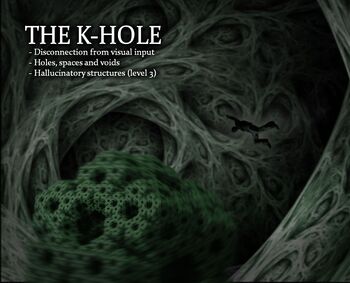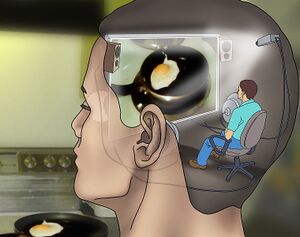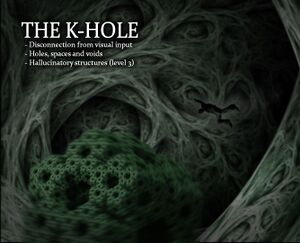Visual disconnection
Visual disconnection is the experience of becoming distant and detached from one's sense of vision. At its lower levels, this leads to states such as visual acuity suppression, double vision, pattern recognition suppression, and visual processing deceleration. The experience of this effect can also create a wide range of subjective changes to a person's perception of their own vision. These are described and documented in the list below:
- Feeling as if one is watching the world through a screen
- Blurred vision and a general difficulty in perceiving fine details
- Feeling as if the visually perceivable world is more distant
- Feeling as if one is looking at the world through someone else's eyes
- A Double vision which, at higher levels, forces the user to close one eye if they need to read or perceive fine visual details
Visual disconnection is often accompanied by other coinciding effects such as cognitive disconnection and physical disconnection in a manner which results in the sensation that one is partially or entirely detaching from both their sensory input and their cognitive faculties. This effect is most commonly induced under the influence of moderate dosages of depressant and dissociative compounds, such as, ketamine, PCP, and DXM.
At its higher levels, visual disconnection can become all-encompassing in its effects. This results in a complete perceptual disconnection from one's sense of sight which can be described as the experience of being blinded and unable to tell whether the eyes are open or closed due to a total lack of sensory input. During this state, the effect often leads one into the experience of finding themselves floating through a dark and mostly empty hallucinatory void.
Image examples
Holes, spaces and voids

Holes, spaces and voids are a sub-component of visual disconnection that manifests when it has become all-encompassing in its intensity. This experience is more commonly known within the literature as the "K-hole" and is generally discussed as something which is associated specifically with ketamine despite being present within most traditional dissociatives. It can be described as the place a person finds themselves at once visual disconnection becomes powerful enough to leave the person incapable of receiving external sensory input. This replaces their visual input with a space that subjectively feels as if it is outside of ordinary reality.
The visual appearance of this space, hole, or void can be described as a vast, mostly empty and darkened chamber which often feels and appears to be infinite in size. This space is usually dark black but can occasionally display itself with large patches of slow-moving amorphous colour clouds or subtle geometric patterns across its horizon. At its higher levels, these voids are often populated with hallucinatory structures which are comprehensively described and documented in the subsection below.
Alongside this visual experience changes in gravity and a powerful sense of tactile disconnection are also usually present which can result in one feeling as if they are undergoing an out-of-body experience while weightlessly floating through a void over great distances in a variety of different speeds, directions, and orientations. This is a feeling that is interpreted by many people as floating through space or the night sky.
Structures
Structures are the only feature found within what would otherwise be empty and uninhabited voids. These manifest as the visual experience of monolithic 3-dimensional shapes or structures of an infinite variety and size which float above, below, around, or in front of a person as they gradually zoom, rotate, transform, or pan into focus and become unveiled before the person's line of sight at a gradual pace.
These structures can take the form of any shape but common examples include vast and giant pillars, columns, tunnels, blocks, buildings, slides, monuments, wheels, pyramids, caves, and a variety of abstract shapes. They are often fractal in shape and can manifest in a variety of colours, but usually follow darker themes and tones with an associated aesthetic that is sometimes subjectively interpreted as "alien" in nature.
Structures can be broken down into the 4 basic levels of complexity and visual intensity described below:
- 2-Dimensional Structures - At the lowest level, structures confine their form to strictly 2-Dimensional shapes. These shapes are usually flat and dark in their colour. Their presence is also often “felt” instead of seen. In terms of their size, these structures usually take up the entirety of a person's visual field but do not appear to have any particular sense of size attributed to them.
- Partially defined 3-Dimensional Structures - At this level, the structures become better defined and 3-dimensional in shape with some basic detail to their lighting and shadows. They appear to be comprised of semi-transparent condensed colour and are seen as ill-defined or out of focus around their edges. In terms of size, these structures appear to be extremely large, stretching out across up to hundreds of meters.
- Fully defined 3-Dimensional Structures - At this level, structures become fully defined in their shape, edges, lighting, shadow, and detail. They often appear to be made of solid and dense realistic materials such as stone and metal. In terms of their size, they are capable of appearing as thousands of miles across themselves and are often extremely complex in terms of their shape and texture.
- Structural machine-universes - At its highest level, hallucinatory structures can be described as the sensation of seeing that which is subjectively perceived as the entire universe condensed into an infinitely vast and intricate ever-shifting machine structure. In terms of its appearance, this state is tough to describe but has many subjective similarities to level 8A geometry. The structure can take any form, but usually, appear as intricately shaped machine-like structures that are seemingly infinite in size and can convey vast amounts of innately understandable information. This experience is not just perceived through one's sense of sight but is also physically felt in an incomprehensible level of detail that manifests itself as complex cognitive and tactile sensations. The structure as a whole and the information it conveys are often innately interpreted as perceiving a structural representation of “the universe” or “everything”.
Structures typically display themselves from anywhere between 30 seconds to several minutes before the person experiencing them slips back into reality or the presence of another structure. In terms of how these structures shift between each other, their transition processes can be broken down into 4 basic categories. These are described and documented below:
- Structural transformations - Structures can switch between each other by transforming or shapeshifting in a static and comprehensible way. This is something that usually unfolds in a gradual step by step morphing process.
- Structural panning - Structures can switch between each other by remaining static in their shape but merely panning out of view until they are no longer within one's field of vision. It’s from here that another structure usually comes into view from outside of one's peripheral vision within a few seconds to a couple of minutes.
- Traveling over great distances - The third method of transitioning is experienced when the structures appear to be stationary while one is floating silently between them over what can feel like extreme physical distances. This floating is sometimes felt to occur on an invisible rail through the vast and infinite dissociative hole.
Psychoactive substances
Compounds within our psychoactive substance index which may cause this effect include:
Experience reports
Anecdotal reports which describe this effect within our experience index include:
- Experience:1000mg / 1200mg / 1400mg / 1600mg - heroic doses
- Experience:1050 µg 1cP-LSD - The matrix
- Experience:1064mgs - Fascinating DXM experience - Unusual effects
- Experience:110mg Diphenidine (vaporized) + 354mg DXM - instant ego death
- Experience:12 mg AMT - Nicely Surprised
- Experience:2mg Etizolam & N2O - "Hippy Crack" Indeed
- Experience:354mg DXM, weed, nicotine - Descending into the void
- Experience:50mg - Diphenidine ride
- Experience:700mg - To the dextroverse.
- Experience:DXM and Cannabis: 100mg - Unexpected Strong Trip
- Experience:Ephenidine:185mg - A Weird and Rewarding Trip
- Experience:MXE: 37.5 mg - Calm and Cloudy Bliss



